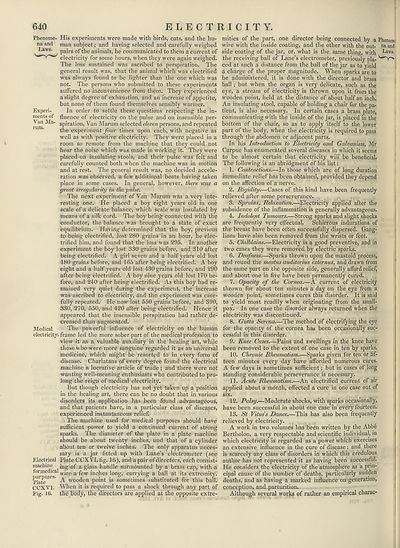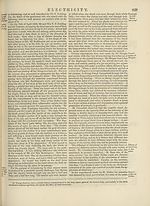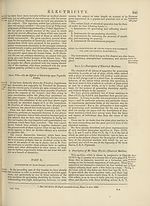Encyclopaedia Britannica > Volume 8, DIA-England
(650) Page 640
Download files
Complete book:
Individual page:
Thumbnail gallery: Grid view | List view

ELECTRICITY.
640
Phenome- His experiments were made with birds, cats, and the hu-
na and raan subject; and having selected and carefully weighed
i ^WS' , pairs of the animals, he communicated to them a current of
electricity for some hours, when they were again weighed.
The loss sustained was ascribed to perspiration. The
general result was, that the animal which was electrified
was always found to be lighter than the one which was
not. The persons who submitted to these experiments
suffered no inconvenience from them. They experienced
a slight degree of exhaustion, and an increase of appetite,
but none of them found themselves sensibly warmer.
Experi- In order to settle these questions respecting the in-
ments of fluence of electricity on the pulse and on insensible per-
Van Ma- Spirationj yan Marum selected eleven persons, and repeated
the experiment four times upon each, with negative as
well as with positive electricity. They were placed in a
room so remote from the machine that they could not
hear the noise which was made in working it. They were
placed on insulating stools, and their pulse was felt and
carefully counted both when the machine was in motion
and at rest. The general result wras, no decided accele¬
ration was observed, a few additional beats having taken
place in some cases. In general, however, there was a
great irregularity in the •pulse.
The next experiment of Van Marum was a very inte¬
resting one. He placed a boy eight years old in one
scale of a delicate balance, which scale was insulated by
means of a silk cord. The boy being connected with the
conductor, the balance was brought to a state of exact
equilibrium. Having determined that the boy, previous
to being electrified, lost 280 grains in an hour, he elec¬
trified him, and found that the loss was 295. In another
experiment the boy lost 330 grains before, and 310 after
being electrified. A girl seven and a half years old lost
180 grains before, and 165 after being electrified. A boy
eight and a half years old lost 430 grains before, and 290
after being electrified. A boy nine years old lost 170 be¬
fore, and 240 after being electrified. As this boy had re¬
mained very quiet during the experiment, the increase
was ascribed to electricity, and the experiment was care¬
fully repeated. He now lost 550 grains before, and 390,
330, 270, 550, and 420 after being electrified. Hence it
appeared that the insensible perspiration had rather de¬
creased than augmented.
Medical The powerful influence of electricity on the human
electricity, frame led the more sober part of the medical profession to
view it as a valuable auxiliary in the healing art, while
those who were more sanguine regarded it as an universal
medicine, which might be resorted to in every form of
disease. Charlatans of every degree found the electrical
machine a lucrative article of trade ; and there were not
wanting well-meaning enthusiasts who contributed to pro¬
long the reign of medical electricity.
But though electricity has not yet taken up a position
in the healing art, there can be no doubt that in various
disorders its application has been found advantageous,
and that patients have, in a particular class of diseases,
experienced instantaneous relief.
The machine used for medical purposes should have
sufficient power to yield a continued current of strong
sparks. The diameter of the plate in a plate machine
should be about twenty inches, and that of a cylinder
about ten or twelve inches. The only apparatus neces¬
sary is a jar fitted up with Lane’s electrometer (see
Electrical Plate CCXVI. fig. 16), and a pair of directors, each consist-
machine ;ng 0f a glass handle surmounted by a brass cap, with a
for medical w|re a few. jnc]ies long, carrying a ball at its extremity.
Plate°SeS' ^ wooden point is sometimes substituted for this ball.
CCXVI. When it is required to pass a shock through any part of
Fig. 16. the body, the directors are applied at the opposite extre¬
mities of the part, one director being connected by a Phenom
wire with the inside coating, and the other with the out- na and
side coating of the jar, or, what is the same thing, ■with ^,aws-
the receiving ball of Lane’s electrometer, previously pla-
ced at such a distance from the ball of the jar as to yield
a charge of the proper magnitude. When sparks are to
be administered, it is done with the director and brass
ball; but when the organ is very delicate, such as the
eye, a stream of electricity is thrown upon it from the
wooden point, held at the distance of about half an inch.
An insulating stool, capable of holding a chair for the pa¬
tient, is also necessary. In certain cases a brass plate,
communicating with the inside of the jar, is placed in the
bottom of the chair, so as to apply itself to the lower
part of the body, when the electricity is required to pass
through the abdomen or adjacent parts.
In his Introduction to Electricity and Galvanism, Mr
Carpue has enumerated several diseases in which it seems
to be almost certain that electricity will be beneficial,
The following is an abridgment of his list:
1. Contractions.—In those which are of long duration
immediate relief has been obtained, provided they depend
on the affection of a nerve.
2. Rigidity.—Cases of this kind have been frequently
relieved after some perseverance.
3. Sprains, Relaxation.—Electricity applied after the
subsidence of the inflammation is generally advantageous.
4. Indolent Tumours.—Strong sparks and slight shocks
are frequently very effectual. Schirrous indurations of
the breast have been often successfully dispersed. Gang¬
lions have also been removed from the wrists or feet.
5. Chilblains.—Electricity is a good preventive, and in
two cases they were removed by electric sparks.
6. Deafness.—Sparks thrown upon the mastoid process,
and round the meatus auditorius externus, and drawn from
the same part on the opposite side, generally afford relief,
and about one in five have been permanently cured.
7. Opacity of the Cornea.—A current of electricity
thrown for about ten minutes a day on the eye from a
wooden point, sometimes cures this disorder. It is said
to yield most readily when originating from the small¬
pox. In one case the disorder always returned when the
electricity was discontinued.
8. Gutta Serena.—The method of electrifying the eye
for the opacity of the cornea has been occasionally suc¬
cessful in this disorder.
9. Knee Cases.—Pains and swellings in the knee have
been removed to the extent of one case in ten by sparks.
10. Chronic Rheumatism.—Sparks given for ten or fif¬
teen minutes every day have afforded numerous cures.
A few days is sometimes sufficient; but in cases of long
standing considerable perseverance is necessary.
11. Acute Rheumatism.—An electrified current of air
applied about a month, effected a cure in one case out of
six.
12. Palsy.—Moderate shocks, with sparks occasionally,
have been successful in about one case in every fourteen.
13. St Vitus’s Dance.—This has also been frequently
relieved by electricity.
A work in two volumes has been written by the Abbe
Bertholon, a very respectable and scientific individual, in
which electricity is regarded as a power which exercises
an extensive influence in the cure of disease; and there
is scarcely any class of disorders in which this credulous
author has not represented it as having been successful.
He considers the electricity of the atmosphere as a prin¬
cipal cause of the number of deaths, particularly sudden
deaths, and as having a marked influence on generation,
conception, and parturition.
Although several works of rather an empirical charac-
640
Phenome- His experiments were made with birds, cats, and the hu-
na and raan subject; and having selected and carefully weighed
i ^WS' , pairs of the animals, he communicated to them a current of
electricity for some hours, when they were again weighed.
The loss sustained was ascribed to perspiration. The
general result was, that the animal which was electrified
was always found to be lighter than the one which was
not. The persons who submitted to these experiments
suffered no inconvenience from them. They experienced
a slight degree of exhaustion, and an increase of appetite,
but none of them found themselves sensibly warmer.
Experi- In order to settle these questions respecting the in-
ments of fluence of electricity on the pulse and on insensible per-
Van Ma- Spirationj yan Marum selected eleven persons, and repeated
the experiment four times upon each, with negative as
well as with positive electricity. They were placed in a
room so remote from the machine that they could not
hear the noise which was made in working it. They were
placed on insulating stools, and their pulse was felt and
carefully counted both when the machine was in motion
and at rest. The general result wras, no decided accele¬
ration was observed, a few additional beats having taken
place in some cases. In general, however, there was a
great irregularity in the •pulse.
The next experiment of Van Marum was a very inte¬
resting one. He placed a boy eight years old in one
scale of a delicate balance, which scale was insulated by
means of a silk cord. The boy being connected with the
conductor, the balance was brought to a state of exact
equilibrium. Having determined that the boy, previous
to being electrified, lost 280 grains in an hour, he elec¬
trified him, and found that the loss was 295. In another
experiment the boy lost 330 grains before, and 310 after
being electrified. A girl seven and a half years old lost
180 grains before, and 165 after being electrified. A boy
eight and a half years old lost 430 grains before, and 290
after being electrified. A boy nine years old lost 170 be¬
fore, and 240 after being electrified. As this boy had re¬
mained very quiet during the experiment, the increase
was ascribed to electricity, and the experiment was care¬
fully repeated. He now lost 550 grains before, and 390,
330, 270, 550, and 420 after being electrified. Hence it
appeared that the insensible perspiration had rather de¬
creased than augmented.
Medical The powerful influence of electricity on the human
electricity, frame led the more sober part of the medical profession to
view it as a valuable auxiliary in the healing art, while
those who were more sanguine regarded it as an universal
medicine, which might be resorted to in every form of
disease. Charlatans of every degree found the electrical
machine a lucrative article of trade ; and there were not
wanting well-meaning enthusiasts who contributed to pro¬
long the reign of medical electricity.
But though electricity has not yet taken up a position
in the healing art, there can be no doubt that in various
disorders its application has been found advantageous,
and that patients have, in a particular class of diseases,
experienced instantaneous relief.
The machine used for medical purposes should have
sufficient power to yield a continued current of strong
sparks. The diameter of the plate in a plate machine
should be about twenty inches, and that of a cylinder
about ten or twelve inches. The only apparatus neces¬
sary is a jar fitted up with Lane’s electrometer (see
Electrical Plate CCXVI. fig. 16), and a pair of directors, each consist-
machine ;ng 0f a glass handle surmounted by a brass cap, with a
for medical w|re a few. jnc]ies long, carrying a ball at its extremity.
Plate°SeS' ^ wooden point is sometimes substituted for this ball.
CCXVI. When it is required to pass a shock through any part of
Fig. 16. the body, the directors are applied at the opposite extre¬
mities of the part, one director being connected by a Phenom
wire with the inside coating, and the other with the out- na and
side coating of the jar, or, what is the same thing, ■with ^,aws-
the receiving ball of Lane’s electrometer, previously pla-
ced at such a distance from the ball of the jar as to yield
a charge of the proper magnitude. When sparks are to
be administered, it is done with the director and brass
ball; but when the organ is very delicate, such as the
eye, a stream of electricity is thrown upon it from the
wooden point, held at the distance of about half an inch.
An insulating stool, capable of holding a chair for the pa¬
tient, is also necessary. In certain cases a brass plate,
communicating with the inside of the jar, is placed in the
bottom of the chair, so as to apply itself to the lower
part of the body, when the electricity is required to pass
through the abdomen or adjacent parts.
In his Introduction to Electricity and Galvanism, Mr
Carpue has enumerated several diseases in which it seems
to be almost certain that electricity will be beneficial,
The following is an abridgment of his list:
1. Contractions.—In those which are of long duration
immediate relief has been obtained, provided they depend
on the affection of a nerve.
2. Rigidity.—Cases of this kind have been frequently
relieved after some perseverance.
3. Sprains, Relaxation.—Electricity applied after the
subsidence of the inflammation is generally advantageous.
4. Indolent Tumours.—Strong sparks and slight shocks
are frequently very effectual. Schirrous indurations of
the breast have been often successfully dispersed. Gang¬
lions have also been removed from the wrists or feet.
5. Chilblains.—Electricity is a good preventive, and in
two cases they were removed by electric sparks.
6. Deafness.—Sparks thrown upon the mastoid process,
and round the meatus auditorius externus, and drawn from
the same part on the opposite side, generally afford relief,
and about one in five have been permanently cured.
7. Opacity of the Cornea.—A current of electricity
thrown for about ten minutes a day on the eye from a
wooden point, sometimes cures this disorder. It is said
to yield most readily when originating from the small¬
pox. In one case the disorder always returned when the
electricity was discontinued.
8. Gutta Serena.—The method of electrifying the eye
for the opacity of the cornea has been occasionally suc¬
cessful in this disorder.
9. Knee Cases.—Pains and swellings in the knee have
been removed to the extent of one case in ten by sparks.
10. Chronic Rheumatism.—Sparks given for ten or fif¬
teen minutes every day have afforded numerous cures.
A few days is sometimes sufficient; but in cases of long
standing considerable perseverance is necessary.
11. Acute Rheumatism.—An electrified current of air
applied about a month, effected a cure in one case out of
six.
12. Palsy.—Moderate shocks, with sparks occasionally,
have been successful in about one case in every fourteen.
13. St Vitus’s Dance.—This has also been frequently
relieved by electricity.
A work in two volumes has been written by the Abbe
Bertholon, a very respectable and scientific individual, in
which electricity is regarded as a power which exercises
an extensive influence in the cure of disease; and there
is scarcely any class of disorders in which this credulous
author has not represented it as having been successful.
He considers the electricity of the atmosphere as a prin¬
cipal cause of the number of deaths, particularly sudden
deaths, and as having a marked influence on generation,
conception, and parturition.
Although several works of rather an empirical charac-
Set display mode to:
![]() Universal Viewer |
Universal Viewer | ![]() Mirador |
Large image | Transcription
Mirador |
Large image | Transcription
Images and transcriptions on this page, including medium image downloads, may be used under the Creative Commons Attribution 4.0 International Licence unless otherwise stated. ![]()
| Encyclopaedia Britannica > Encyclopaedia Britannica > Volume 8, DIA-England > (650) Page 640 |
|---|
| Permanent URL | https://digital.nls.uk/193331455 |
|---|
| Attribution and copyright: |
|
|---|
| Description | Ten editions of 'Encyclopaedia Britannica', issued from 1768-1903, in 231 volumes. Originally issued in 100 weekly parts (3 volumes) between 1768 and 1771 by publishers: Colin Macfarquhar and Andrew Bell (Edinburgh); editor: William Smellie: engraver: Andrew Bell. Expanded editions in the 19th century featured more volumes and contributions from leading experts in their fields. Managed and published in Edinburgh up to the 9th edition (25 volumes, from 1875-1889); the 10th edition (1902-1903) re-issued the 9th edition, with 11 supplementary volumes. |
|---|---|
| Additional NLS resources: |
|

